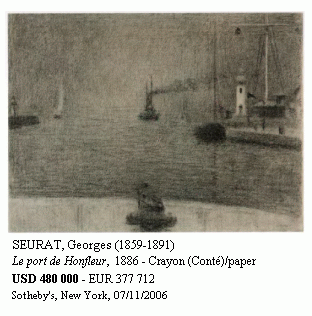Georges Seurat – drawings
[06 Nov 2007]
Leading light of neo-impressionism and father of pointillism, George Seurat is being honoured by the MoMA (New York) until 7 January 2008 with an original exhibition entirely dedicated to his drawings. The exhibition strikingly reveals the technique Seurat used for producing black and white drawings on paper with an exceptional degree of luminosity. Indeed, it was one such drawing Portrait d’Aman-Jean that got the artist his first and only appearance at the Salon officiel in 1883. The following year, his painting entitled Une Baignade, Asnières was refused by the Salon!
As Georges Pierre SEURAT died of angina at the young age of 31, the total volume of his works is somewhat modest with less than 500 drawings. The collection presented at the MoMA contains some highly successful drawings including Parisian scenes and portraits but also drawing books and a broad range of preparatory works for major works such as the famous painting Un dimanche après-midi à la Grande Jatte.

As the artist’s technique developed, he started using Michalet paper combined with Conté pencils; these works attract the greatest interest – and prices – at auctions. For example in November 2006, a Georges Seurat drawing entitled Le port de Honfleur (1886) fetched no less than USD 480,000! However, his price record for drawings has not been broken for a long time. In November 1991, a Seurat drawing entitled Le Moissonneur (1881) went under the hammer of the auctioneer Maître Loudmer for the equivalent of USD 800,000. In fact drawings represent close to three quarters of the artist’s total volume of work and only 105 lots of his works have come up for auction over the last 20 years. His less developed preparatory sketches sometimes change hands for less than EUR 10,000. In May 2007, at Christie’s Paris, a page of small lead pencil and colour crayon sketches entitled Soldats, rade de Brest, sold for EUR 6,200 € (USD 8,345).
Seurat’s all-time price record was set in 1999 by his painting Paysage, l’île de la Grande Jatte (1884). The work, in addition to its reference to the artist’s most famous piece, also came from an exceptional source: the Whitney collection. Its quality and pedigree resulted in a final bid of USD 32 million.




 0
0
